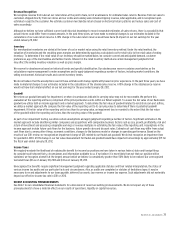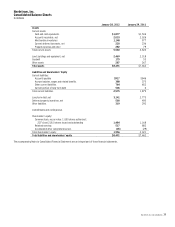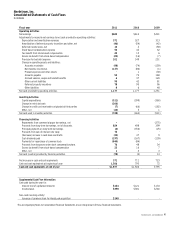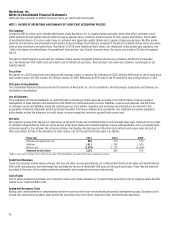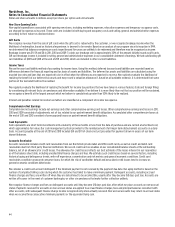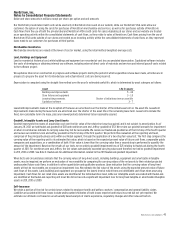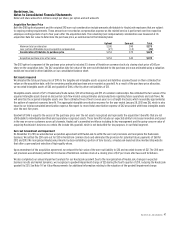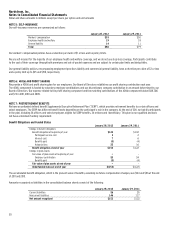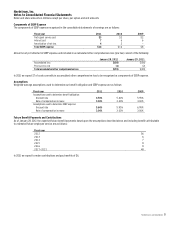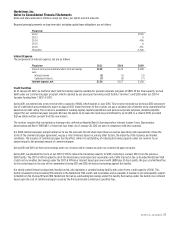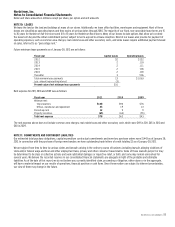Nordstrom 2011 Annual Report Download - page 45
Download and view the complete annual report
Please find page 45 of the 2011 Nordstrom annual report below. You can navigate through the pages in the report by either clicking on the pages listed below, or by using the keyword search tool below to find specific information within the annual report.
Nordstrom, Inc. and subsidiaries 45
Nordstrom, Inc.
Notes to Consolidated Financial Statements
Dollar and share amounts in millions except per share, per option and unit amounts
Our Nordstrom private label credit card can be used only in Nordstrom stores and on our website, while our Nordstrom VISA cards allow our
customers the option of using the cards for purchases of Nordstrom merchandise and services, as well as for purchases outside of Nordstrom.
Cash flows from the use of both the private label and Nordstrom VISA credit cards for sales originating at our stores and our website are treated
as an operating activity within the consolidated statements of cash flows, as they relate to sales at Nordstrom. Cash flows arising from the use of
Nordstrom VISA cards outside of our stores are treated as an investing activity within the consolidated statements of cash flows, as they represent
loans made to our customers for purchases at third parties.
Merchandise Inventories
Merchandise inventories are valued at the lower of cost or market, using the retail method (weighted-average cost).
Land, Buildings and Equipment
Land is recorded at historical cost, while buildings and equipment are recorded at cost less accumulated depreciation. Capitalized software includes
the costs of developing or obtaining internal-use software, including external direct costs of materials and services and internal payroll costs related
to the software project.
We capitalize interest on construction in progress and software projects during the period in which expenditures have been made, activities are in
progress to prepare the asset for its intended use and actual interest costs are being incurred.
Depreciation is computed using the straight-line method over the asset’s estimated useful life, which is determined by asset category as follows:
Asset Life (in years)
Buildings and improvements 5 – 40
Store fixtures and equipment 3 – 15
Leasehold improvements Shorter of initial lease term or asset life
Capitalized software 3 – 7
Leasehold improvements made at the inception of the lease are amortized over the shorter of the initial lease term or the asset life. Leasehold
improvements made during the lease term are amortized over the shorter of the asset life or the remaining lease term. Lease terms include the
fixed, non-cancelable term of a lease, plus any renewal periods determined to be reasonably assured.
Goodwill, Intangible Assets and Long-Lived Assets
Goodwill represents the excess of acquisition cost over the fair value of the related net assets acquired, and is not subject to amortization. As of
January 28, 2012, we had HauteLook goodwill of $121 and nordstrom.com and Jeffrey goodwill of $53. We review our goodwill annually for impairment
or when circumstances indicate its carrying value may not be recoverable. We review our HauteLook goodwill as of the first day of the fourth quarter
and review our nordstrom.com and Jeffrey goodwill on the first day of the first quarter. We perform this evaluation at the reporting unit level,
comprised of the principal business units within our Retail segment, through the application of a two-step fair value test. The first step compares the
carrying value of the reporting unit to its estimated fair value, which is based on the expected present value of future cash flows, comparable public
companies and acquisitions, or a combination of both. If fair value is lower than the carrying value then a second step is performed to quantify the
amount of the impairment. Based on the results of our tests, we recorded a goodwill impairment loss of $25 relating to HauteLook during the fourth
quarter of 2011. For nordstrom.com and Jeffrey, the fair values substantially exceeded carrying values and therefore we had no goodwill impairment
in 2011, 2010 or 2009. See Note 2: HauteLook for additional information related to the 2011 HauteLook goodwill impairment.
When facts and circumstances indicate that the carrying values of long-lived assets, including buildings, equipment and amortizable intangible
assets, may be impaired, we perform an evaluation of recoverability by comparing the carrying values of the net assets to their related projected
undiscounted future cash flows, in addition to other quantitative and qualitative analyses. Upon indication that the carrying values of long-lived
assets will not be recoverable, we recognize an impairment loss. We estimate the fair value of the assets using the expected present value of future
cash flows of the assets. Land, buildings and equipment are grouped at the lowest level at which there are identifiable cash flows when assessing
impairment. Cash flows for our retail store assets are identified at the individual store level, while our intangible assets associated with HauteLook
are identified at the HauteLook reporting unit level. We did not record a significant impairment loss for long-lived tangible or amortizable intangible
assets in 2011, 2010 or 2009.
Self-Insurance
We retain a portion of the risk for certain losses related to employee health and welfare, workers’ compensation and general liability claims.
Liabilities associated with these losses include undiscounted estimates of both losses reported and losses incurred but not yet reported. We
estimate our ultimate cost based on an actuarially based analysis of claims experience, regulatory changes and other relevant factors.


